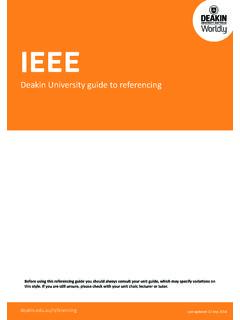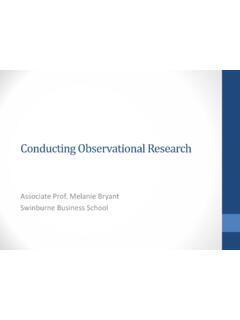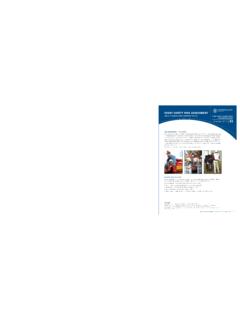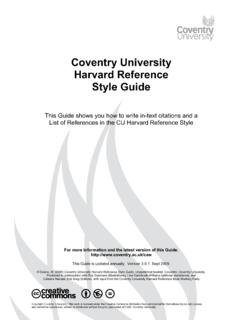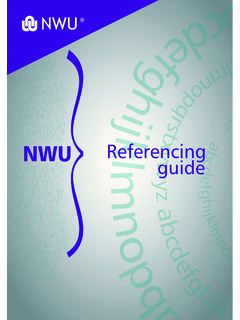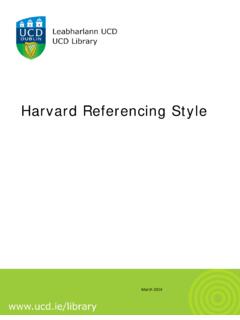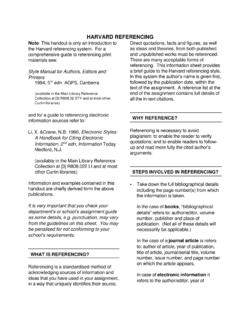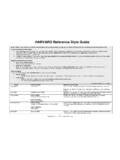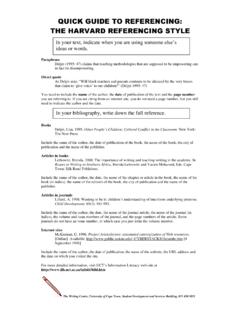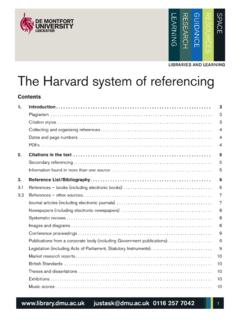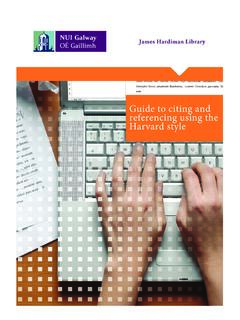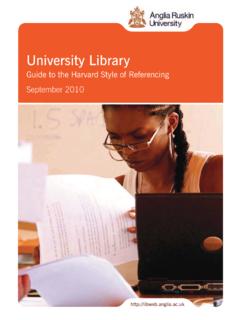Transcription of HARVARD - Deakin
1 HARVARD Deakin guide to referencing Please be aware that variations of the HARVARD style of referencing are used by different universities and publishers. Unlike many other styles , there is no single authority on HARVARD style. Before using this guide, please consult your unit guide, which may specify variations on this style. If you are still unsure, please check with your unit chair, lecturer or tutor. Where possible, the information for this guide has been based on: Snooks & Co. 2002, Style manual for authors, editors and printers, 6th edn, rev. John Wiley & Sons, Milton, Qld. Last updated: 14 June 2017 Deakin guide to referencing: HARVARD (last updated 14/6/2017) 2 Table of Contents General principles .. 3 How do I format in-text citations?
2 3 How do I compile a reference list? .. 5 Group author .. 6 No author .. 6 No date .. 6 Multiple authors of a single work .. 7 Citing multiple source at the same point .. 7 Repeat citations in the same paragraph .. 7 Secondary sources .. 8 Multiple publications by the same author in the same year .. 8 Books .. 8 reference list entries .. 8 One, two or three authors .. 9 More than three authors .. 10 Chapter in an edited book .. 10 e-book .. 11 Dictionary or encyclopedia .. 11 Work other than a first edition .. 12 Periodicals .. 12 Print journal article one to three authors .. 12 e-journal article one to three authors .. 13 Journal article four or more authors .. 14 Newspaper article .. 14 Newspaper article no author .. 15 Newspaper article online or database.
3 15 Review in a periodical .. 15 Images .. 15 Image from a print publication .. 15 Image from a database .. 16 Image from a website .. 16 Reproducing figures in assignments .. 16 Artwork in museum/gallery .. 17 Online, broadcast, video .. 17 Social media .. 17 Webpage or document from a website .. 18 Wiki .. 19 Blog .. 19 Podcast or streaming video .. 20 Film, DVD, video, CD-ROM .. 20 Television and radio .. 21 Other sources .. 21 ABS statistics .. 21 Advertisement in a print publication .. 21 Deakin guide to referencing: HARVARD (last updated 14/6/2017) 3 Brochures, posters, pamphlets .. 22 Conference paper .. 22 Course materials .. 23 Government publications .. 23 Legal sources .. 24 Media release .. 26 Personal communication .. 26 Report.
4 26 Software and games .. 27 Standards .. 28 Table or chart .. 28 Thesis .. 29 Translated work .. 29 General principles The following principles of the HARVARD referencing style apply to all sources, including print, electronic and multimedia sources. The HARVARD style consists of two elements: in-text citations in the body of the paper that include the author, the date and often a page number a reference list at the end of the paper giving full bibliographic details of all in-text citations. Note that you may not always find an example of the specific source you want to reference . Sometimes you may have to combine elements from more than one section in this guide to determine the correct referencing format. How do I format in-text citations?
5 HARVARD in-text citations consist of the family name of the author and the year of publication. In addition, page numbers should be included when paraphrasing (rephrasing a short passage) or quoting directly from a source. A comma is placed between the year and the page number. An in-text citation can go at the beginning, the middle or the end of a sentence. For citations you can emphasise the author: Salzmann, Stanlaw and Adachi (2012, p. 4) further explore the established misconception that unwritten languages are primitive. Or the information: A common misconception is that unwritten languages are primitive (Salzmann, Stanlaw & Adachi 2012, p. 4). Note in the examples above that the word 'and' is used when the family names are part of the sentence, but an ampersand (&) is used when the names are in parentheses.
6 Deakin guide to referencing: HARVARD (last updated 14/6/2017) 4 There are three ways to cite your sources. 1. Summary or general reference A summary of a work or section of a work, or a general reference to someone's work or ideas, requires a citation. Include the author and the date. According to Foster (2008), the work represents an emotional essence distilled from multiple fleeting insights. 2. Paraphrase A paraphrase is the expression of the same idea in different words. When you paraphrase, it is advisable to include a page number within the in-text citation. The number of applications to nursing schools in England has increased by twenty-five per cent (Sprinks 2010, p. 11). 3. Quote A direct quote is the exact reproduction of someone s words.
7 Direct quotes always require a page number within the in-text citation. UNESCO's communication model is reminiscent of the media paradigm in which 'each receiver becomes a potential transmitter' (Enzenburger 1970, p. 26). Short quotes A short quote is a sentence or part of a sentence (fewer than about 30 words) that is reproduced exactly from a source. Single quotation marks are used at the start and end of the quote. The citation relates to the sentence in which it appears, so a full stop is placed after the citation. The most important effects are 'provided by the use of pitch or melody' (Crystal 1987, p. 169). Other effects include .. Block quotes A block quote is a longer quote, more than about 30 words. Block quotes are set off from the body of the paper by indenting.
8 Quotation marks are not required for block quotes. The final full stop is placed before the in-text citation because the in-text citation relates to all the sentences in the block quote, not just to the last sentence. While the main text is often or double-spaced, the indented block quote should be both single-spaced and a smaller font size. Morley-Warner (2001) suggests that students should focus on how journal articles in their subject are written and structured. She describes a benefit of this process: You will also gain a sense of the complexity of being an apprentice writer in an academic culture, or rather cultures, where expectations may vary from discipline to discipline, even subject to subject and where you can build a repertoire of critical thinking and writing skills that enable you to enter the academic debates, even to challenge.
9 (Morley-Warner 2001, p. 6) Reading is central to study at university. It is through reading that .. Deakin guide to referencing: HARVARD (last updated 14/6/2017) 5 How do I compile a reference list? An important purpose of the reference list is to enable readers to locate sources. Therefore details must be correct and complete. It is important that each in-text citation and the related reference list entry are identical in spelling and year. The reference list should include: full bibliographic details according to the source type all the works cited in the paper and no works that are not cited works listed in alphabetical order by family name of author or by name of authoring organisation works listed alphabetically by title where there is no author (disregarding 'A', 'An' or 'The' at the beginning of the title)
10 One listing per work, regardless of how many times it is cited in text commas separating elements of the citation rather than full stops and no full stops after initials the state or country for a relatively unknown place of publication, or where city names can be confused, Cambridge MA or Cambridge UK an author's name only in the first instance where the author has multiple entries and a long dash in place of the author's name for subsequent entries lower case letters following the year where an author has multiple entries in the same year, 2001a, 2001b, 2001c. Sample reference list Barikin, A 2012, Parallel presents: the art of Pierre Huyghe, MIT Press, Cambridge, MA. Clarke, DB, Doel, MA, Merrin, W & Smith, RG (eds) 2009, Jean Baudrillard: fatal theories, Taylor & Francis, retrieved 23 September 2013, Ebook Library database.

